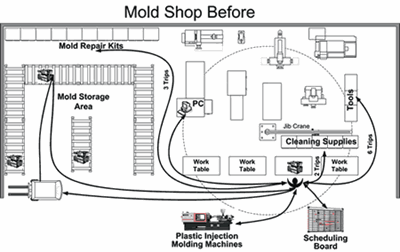Five Whys Problem Solving
How to apply the right lean tool for a given problem.
The Five Whys is a simple process to follow to solve any problem. It starts with writing or having an effective problem statement. Problem statements determine the direction we head next. If we get it wrong, every step that follows will be wrong. Problem statements should describe the current condition, use data where possible, and describe the gap in performance. You also should be open to changing the problem statement as you learn more during your investigation. In writing problem statements, you should avoid describing the solution, postulate as to the expected cause, be vague or ambiguous or combine multiple problems into one.
Some examples of good problem statements include:
- Currently entering data into two different systems; tasks are on average 20 percent late from scheduled time.
- Overall customer complaints are up 50 percent.
- The #3 press is consuming $2,000 in repairs monthly.
Once the problem statement is deter-mined, you can begin using the Five Whys to determine the root cause. Ask why to the problem statement and then ask why to that again five times. Five is not a magic number; sometimes it might be two, others nine.
You should not try to jump whys, but precede one why at a time. You can test each answer to your "why" by asking, "If I remove this, will the previous answer go away?" If the answer is no, you haven’t answered why correctly and you should explore it further. If you can’t immediately answer a why, go and observe or collect data until you can see the current condition clearly enough to answer. Because of this, you may not complete a Five Why in one conversation, but may have to observe, collect data and other activities at each level of why. You have gotten to the end, or the root cause, when you can describe the cause of the problem in terms of an activity, connection or flow.
An example follows with the problem that a key piece of equipment failed.
- Why did the equipment fail? Because the circuit board burned out.
- Why did the circuit board burn out? Because it overheated.
- Why did it overheat? Because it wasn’t getting enough air.
- Why was it not getting enough air? Because the filter wasn’t changed.
- Why was the filter not changed? Because there was no preventive maintenance schedule to do so.
That is now a root cause that can be solved. By focusing on the question WHY, we are more likely to avoid using the other W question: WHO.
The purpose is to fix the system, not just remove the symptom. If we aren’t clear about the difference between symptoms and problems, we will not find the root cause effectively. Symptoms are the part we see—the part on the surface. Symptoms are how we know we have a problem. Problems themselves are the cause of that symptom.
Once the root cause is determined, a countermeasure to the problem must be found. Creativity and lean tools are your most powerful allies in this part of the process. Focus on nothing but the root cause in determining the proper countermeasure. All the other work from problem statement to the Five Whys helps to get you to this point.
A vital final step of the process is verifying that the solution worked. This should be done by first seeing that the countermeasure is sustainable and then making sure that the original condition—the symptom—has been eliminated. There are two purposes. The first is to ensure we met our objective: eliminating the adverse condition. The second is where learning occurs. By verifying each countermeasure, we learn what works and what doesn’t.
The Five Whys most obviously and directly relates to the principle of systematic problem solving. Without the intent of the principle behind you, the Five Whys will likely be a shell of a process and not used effectively. Key behaviors that must accompany the Five Whys include 1) surfacing problems quickly; 2) using them as opportunities to move closer to the ideal state; and, 3) focus on the process, not on blaming the person.
The create a learning organization principle also is greatly enabled through the practice of the Five Whys. The Five Whys can become the primary driver of daily learning about the management and improvement of the process. By finding the root cause and then verifying the effectiveness of the countermeasure, deep knowledge of the process can become institutionalized.
Related Content
Tackling a Mold Designer Shortage
Survey findings reveal a shortage of skilled mold designers and engineers in the moldmaking community, calling for intervention through educational programs and exploration of training alternatives while seeking input from those who have addressed the issue successfully.
Read MoreThe Critical Role of Management Representatives in ISO 9001
In ISO 9001 quality management systems, the Management Representative (MR) plays a crucial role. While the 2015 version of ISO 9001 no longer mandates this position, having a trusted management member serve as an MR remains vital for streamlining operations and maintaining quality standards.
Read MoreSteps for Determining Better Mold Prices
Improving your mold pricing requires a deeper understanding of your business.
Read MoreEditorial Guidelines: Editorial Advisory Board
The Editorial Advisory Board of MoldMaking Technology is made up of authorities with expertise within their respective business, industry, technology and profession. Their role is to advise on timely issues, trends, advances in the field, offer editorial thought and direction, review and comment on specific articles and generally act as a sounding board and a conscience for the publication.
Read MoreRead Next
Focus on Tooling Access to Improve Productivity
How to apply lean tools at leverage points in a mold shop to achieve a focused business objective.
Read MoreHow to Use Strategic Planning Tools, Data to Manage the Human Side of Business
Q&A with Marion Wells, MMT EAB member and founder of Human Asset Management.
Read More



















